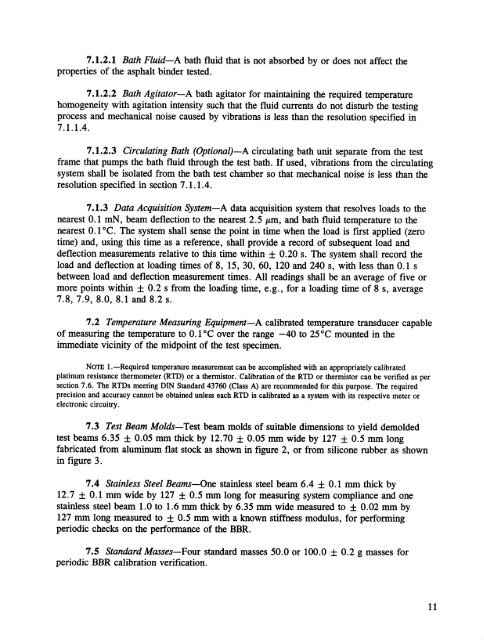Create successful ePaper yourself
Turn your PDF publications into a flip-book with our unique Google optimized e-Paper software.
7.1.2.1 Bath Fluid--A bath fluid that is not absorbed by or does not affect the<br />
properties of the asphalt binder tested.<br />
7.1.2.2 Bath Agitator--A bath agitator for maintaining the required temperature<br />
homogeneity with agitation intensity such that the fluid currents do not disturb the testing<br />
process and mechanical noise caused by vibrations is less than the resolution specified in<br />
7.1.1.4.<br />
7.1.2.3 Circulating Bath (Optional)--A circulating bath unit separate from the test<br />
frame that pumps the bath fluid through the test bath. If used, vibrations from the circulating<br />
system shall be isolated from the bath test chamber so that mechanical noise is less than the<br />
resolution specified in section 7.1.1.4.<br />
7.1.3 Data Acquisition System--A data acquisition system that resolves loads to the<br />
nearest 0.1 mN, beam deflection to the nearest 2.5 #m, and bath fluid temperature to the<br />
nearest 0.1 °C. The system shall sense the point in time when the load is fin'st applied (zero<br />
time) and, using this time as a reference, shall provide a record of subsequent load and<br />
deflection measurements relative to this time within + 0.20 s. The system shall record the<br />
load and deflection at loading times of 8, 15, 30, 60, 120 and 240 s, with less than 0.1 s<br />
between load and deflection measurement times. All readings shall be an average of five or<br />
more points within + 0.2 s from the loading time, e.g., for a loading time of 8 s, average<br />
7.8, 7.9, 8.0, 8.1 and 8.2 s.<br />
7.2 Temperature Measuring EquipmentmA calibrated temperature transducer capable<br />
of measuring the temperature to 0.1°C over the range -40 to 25°C mounted in the<br />
immediate vicinity of the midpoint of the test specimen.<br />
NOTE 1.--Required temperature measurement can be accomplished with an appropriately calibrated<br />
platinum resistance thermometer (RTD) or a thermistor. Calibration of the RTD or thermistor can be verified as per<br />
section 7.6. The RTDs meeting DIN Standard 43760 (Class A) are recommended for this purpose. The required<br />
precision and accuracy cannot be obtained unless each RTD is calibrated as a system with its respective meter or<br />
electronic circuitry.<br />
7.3 Test Beam Molds--Test beam molds of suitable dimensions to yield demolded<br />
test beams 6.35 4- 0.05 mm thick by 12.70 + 0.05 mm wide by 127 4- 0.5 mm long<br />
fabricated from aluminum flat stock as shown in figure 2, or from silicone rubber as shown<br />
in figure 3.<br />
7.4 Stainless Steel Beams--One stainless steel beam 6.4 4- 0.1 mm thick by<br />
12.7 ± 0.1 mm wide by 127 4- 0.5 mm long for measuring system compliance and one<br />
stainless steel beam 1.0 to 1.6 mm thick by 6.35 mm wide measured to 4- 0.02 mm by<br />
127 mm long measured to 4- 0.5 mm with a known stiffness modulus, for performing<br />
periodic checks on the performance of the BBR.<br />
7.5 Standard Masses--Four standard masses 50.0 or 100.0 ± 0.2 g masses for<br />
periodic BBR calibration verification.<br />
11



